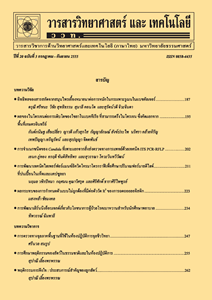Effect of Turmeric Juice and Peppermint Juice on the Quality of Flatbread Roti
Main Article Content
Abstract
This study aimed to assess the potential of turmeric juice and peppermint juice in the levels of 25 and 50 % (w/w) for producing flatbread roti for decreasing the use of synthetic preservative agents (benzoic acid). The results showed that the qualities (including texture, color values, water activity (aw), and microbiological levels) of turmeric juice and peppermint juice treated flatbread roti, were changed during storage for two days at room temperature. However, both treated flatbread roti could be used as a prototype to decrease the use of benzoic acid for prolonging the product shelf-life based on the microbiological criteria of Thai community roti Sai Mai standard (No. 458/2547), including total viable count, yeasts and molds, Bacillus cereus, Staphylococcus aureus, and Escherichia coli, which the shelf-life did not exceed one day in polypropylene bags.
Article Details
References
del Olmo, A., Calzada, J. and Nuñez, M., 2017, Benzoic acid and its derivatives as naturally occurring compounds in foods and as additives: Uses, exposure, and controversy, Crit. Rev. Food Sci. Nutr. 57: 3084-3103.
Gottardi, D., Bukvicki, D., Prasad, S. and Tyagi, A.K., 2016, Beneficial effects of spices in food preservation and safety, Front. Microbiol. 7: 1-20.
Catherine, A.A., Deepika, H. and Negi, P.S., 2012, Antibacterial activity of eugenol and peppermint oil in model food systems, J. Essent. Oil Res. 24: 481-486.
Jing-ping, W.U., 2009, Reviews on natural plant food preservatives and their antibacterial abilities, China Food Additives 2009(3): 61.
Prakash, B., Kedia, A., Mishra, P.K. and Dubey, N.K., 2015, Plant essential oils as food preservatives to control moulds, mycotoxin contamination and oxidative deterioration of agri-food commodities-potentials and challenges, Food Control 47: 381-391.
Thai Community Product Standard (No. 458/2547), Roti Sai Mai, Available Source: http://www.foodnetworksolution.com/wiki/word/4158/โรตีสายไหม, March 10, 2019. (in Thai)
FDA-BAM, 2001, In FDA's bacteriological analytical manual, Available Source: https://www.fda.gov/food/laboratory-me thods-food/bacteriological-analytical-ma nual-bam, January 15, 2019.
Tako, M., Tamaki, Y., Teruya, T. and Takeda, Y., 2014, The principles of starch gelatinization and retrogradation, Food Nutr. Sci. 5: 280-291.
Hidalgo, A. and Brandolini, A., 2011, Evaluation of heat damage, sugars, amylases and colour in breads from einkorn, durum and bread wheat flours, J. Cereal Sci. 54: 90-97.
Prasad, J., Vijay, V.K., Tiwari, G.N. and Sorayan, V.P.S., 2006, Study on performance evaluation of hybrid drier for turmeric (Curcuma longa L.) drying at village scale, J. Food Eng. 75: 497-502.
Pukánszky, B., 1999, Optical Clarity of Polypropylene Products, pp. 554-560, In Polypropylene, Springer, Dordrecht.
Culetu, A., Duta, D.E. and Andlauer, W., 2018, Influence of black tea fractions addition on dough characteristics, textural properties and shelf life of wheat bread, Eur. Food Res. Technol. 244: 1133-1145.
Al-Asmari, F., Mereddy, R. and Sultanbawa, Y., 2017, A novel photosensitization treatment for the inactivation of fungal spores and cells mediated by curcumin, J. Photochem. Photobiol. B Biol. 173: 301-306.
Singh, R.P. and Jain, D.A., 2012, Evaluation of antimicrobial activity of curcuminoids isolated from turmeric, Int. J. Pharm. Life Sci. 3: 1368-1376.
Altunatmaz, S.S., Aksu, F.Y., Issa, G., Kahra man, B.B., Altiner, D.D. and Buyukunal, S.K., 2016, Antimicrobial effects of curcumin against L. monocytogenes, S. aureus, S. Typhimurium and E. coli O157: H7 pathogens in minced meat, Vet. Med. (Praha) 61: 256-262.


